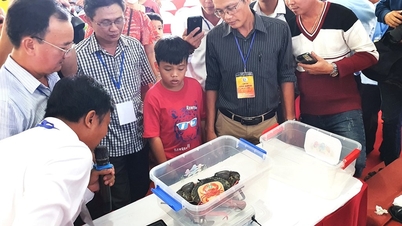HPV virus – the main “culprit” causing cervical cancer, the leading dangerous disease threatening women’s health. Understanding the relationship between HPV virus and cervical cancer accurately is an important basis for women to proactively prevent, screen early, treat promptly and eliminate the threat of this dangerous disease.
Cervical cancer is currently the leading threat to the health and lives of women worldwide.
Statistics from the World Health Organization (WHO) in 2023 show that each year there are nearly 350,000 deaths due to cervical cancer worldwide. In Vietnam, each year there are more than 4,000 new cases of cervical cancer, and more than 2,000 deaths due to this disease.
According to WHO, 99.7% of cervical cancer cases are related to the HPV virus - a virus with nearly 200 types, with 14 types classified as high-risk leading to malignant tumors in the cervix. Of these, the most common are types 16 and 18 - the cause of more than 70% of cervical cancer cases in women.
To better understand the relationship between HPV virus and cervical cancer, please follow the sharing of Associate Professor, Dr. Nguyen Thai Son - Microbiology Expert, Deputy Director of MEDLATEC Testing Center, Former Head of Department, Microbiology Department - Military Hospital 103 (Military Medical Academy), Former Head of Microbiology Department - Military Medical Center (Military Medical Academy) through the interview content below!
Dear expert, HPV is identified as the main cause of cervical cancer. Could you please give a more detailed analysis of the disease-causing mechanism of this virus?
HPV virus is considered the main “culprit” causing cervical cancer. The pathogenesis of this virus is described in detail as follows:
- HPV is a virus that is tropistic to epithelial cells of the genital tract, especially cervical cells in women. When HPV virus attaches to epithelial cells, it will invade and develop, disrupting the normal growth process of cells (also known as dysplasia), causing cells to lose the ability to control growth;
- When cells lose control like this, they will develop in an undirected way and reach a state of unlimited proliferation, which we call cancer;
- The virus will penetrate the mucosal cells first, then penetrate deep below the basement membrane of the cervix.
HPV virus is identified as the main cause of cervical cancer
The process from when the HPV virus attaches to the cell, penetrates and disrupts cell growth usually takes place over a very long period. In normal people, it is about 15-20 years, and for people with weakened immune systems such as those with HIV, or those using immunosuppressive drugs, it is about 5-10 years.
There are more than 200 different types of HPV, so far there is evidence that only 14 types cause cervical cancer, which are called 14 high-risk types, in which HPV types 16 and 18 in particular progress faster than other types, these two types alone cause 70% of cervical cancer cases. Early detection of the presence of HPV types that are at risk of causing cervical cancer will help patients have an effective screening and disease control plan.
Dear expert, when does HPV virus cause cervical cancer faster?
Although HPV is a risk factor for cervical cancer, most women infected with the virus do not develop cancer. It can progress to precancerous or invasive cancer if other factors are present, including:
Factors related to HPV characteristics:
- Different types of virus: There are more than 200 types of HPV, but only a few are high-risk HPV, which can cause cervical cancer and other cancers. Low-risk types (such as HPV types 6 and 11) only cause problems like genital warts and are not linked to cancer;
- Simultaneous infection with multiple cancer-causing strains/types of HPV;
- The number of viruses in the body is large.
Factors related to each person's constitution, such as immunodeficiency due to HIV, or prolonged use of immunosuppressive drugs. In these cases, HPV will persist longer, progressing to cancer more quickly.
Other risk factors:
- Unvaccinated people;
- Co-infection with HIV, or other sexually transmitted diseases;
- People who use birth control pills for a long time (over 5 years).
Besides the common transmission routes, can HPV be transmitted in any other ways that many people do not know?
Until now, many people often think that the main transmission route of HPV is sexual intercourse. In fact, HPV can also be transmitted through many different routes that not everyone knows.
HPV virus can be transmitted through skin-to-skin contact, skin-to-mucous contact. There is a case of a 4-year-old boy who was found to have genital warts, the source of infection was determined to be from his aunt who had genital warts and had frequent contact through caring for, cleaning, and bathing the child.
Next, another way of transmission that many people do not expect is through medical instruments that have not been properly sterilized. In 2017, in Hung Yen, dozens of cases of children with genital warts were discovered. The Ministry of Health sent a team of experts to check the situation and discovered that all of those cases had gone to a private clinic for phimosis treatment. The cause is believed to be the lack of hygiene of medical instruments leading to the spread of the virus.
It is even known that HPV virus can be transmitted through water sources. If you live in a family with someone infected with HPV and use the same washing basin, soak clothes together, wash and dry underwear together, you are also at risk of contracting the virus.
HPV virus can be transmitted through many different ways.
Thus, besides sexual intercourse, HPV virus can be transmitted through many different ways. Actively preventing the spread of this virus is an urgent requirement to protect the health of oneself and the community.
There is an opinion that cervical cancer has a long incubation period but is "as quiet as a mouse", more than 70% of patients are detected in the final stage, what do experts think about that opinion?
This is a sad truth when more than 70% of cervical cancer patients in our country detect the disease at a late stage.
As mentioned above, the progression to cervical cancer takes a long time. The initial signs are often very faint, easily confused with the symptoms of common gynecological diseases. On the other hand, cervical cancer is a disease that can be completely cured if detected at an early stage. According to statistics, the survival rate after 5 years of treatment in stage 1 is 90%, stage 2 is 75%, and by stage 4 when the disease has metastasized, the survival rate is only less than 15%.
According to WHO forecasts, without timely screening, prevention and treatment interventions, in about 10 years, the incidence and mortality rate of cervical cancer will increase by 25% and by 2030 most deaths from the disease will occur in developing countries, including Vietnam.
Therefore, understanding information about the disease to proactively prevent, screen early, and treat promptly is very necessary for women.
Currently, how many methods are used to detect HPV virus? How are these methods implemented at MEDLATEC Testing Center?
To detect HPV, the main method is molecular biology, that is, detecting the specific gene sequence of the HPV virus. This is the most accurate method to detect the presence of high-risk HPV types (especially types that have the potential to cause cancer such as HPV 16, 18 and 12 other high-risk types).
In particular, the technique being deployed at many medical facilities around the world and at MEDLATEC Testing Center is the multi-agent Realtime PCR technique, divided into 2 kits, including a high-risk detection kit and a low-risk detection kit.
However, because multiple agents must be detected at the same time, to ensure stable results, the kits must comply with certain requirements before being allowed to be used for diagnosis.
There are many types of kits on the market today, but only a few are certified for human diagnosis, called IVD certification. Currently, the World Health Organization has recognized the kit manufactured by Roche and running on two Cobas 4800 and 6800 machines because it has been approved by the FDA - the specialized agency responsible for quality control of health-related products in the United States. Therefore, the kit with IVD certification and FDA approval has a very high level of reliability.
MEDLATEC Testing Center is using the Cobas 6800 system, which is the most advanced system, can run multiple samples simultaneously and provide results with the highest level of reliability.
Faced with the current barriers to cervical cancer screening in women, the advent of self-sampling HPV testing technology at home is considered an effective solution. Experts, please comment on the reliability of this method?
Faced with the alarming situation of cervical cancer, but screening still faces many barriers, the HPV testing method with self-sampling tools at home by Roche is considered an effective solution. This method is recommended by the World Health Organization, the American Society of Obstetricians and Gynecologists and the Ministry of Health, bringing many advantages such as initiative, convenience, privacy. In particular, the top important factor is the accuracy, specificity and sensitivity of the HPV self-sampling test method, which have all been studied to achieve and exceed the requirements.
Self-sampling HPV testing service is an effective solution in cervical cancer screening
With the results of the study evaluating its effectiveness, we can completely trust that self-sampling HPV testing will be an effective tool in cervical cancer screening, promising to reach 70% of women worldwide with cervical cancer screening (according to the WHO's 2030 target).
Thank you experts for sharing extremely valuable information about the relationship between HPV virus and cervical cancer. This content will contribute to an important basis to help raise awareness of the community, especially women, about the dangers caused by HPV virus, thereby having a direction for proactive prevention and effective screening.
Accompanying women's health care, from now until December 31, 2024, MEDLATEC Healthcare System offers a special offer - 10% discount on HPV testing for self-sampling at home for only 630,000 VND, applicable nationwide. Contact hotline 1900 56 56 56 immediately to register for incentives. MEDLATEC is ready to support health issues, or schedule quick on-site examination and testing via the 24/7 hotline. For more information, please refer HERE. |






![[Photo] Ca Mau "struggling" to cope with the highest tide of the year, forecast to exceed alert level 3](https://vphoto.vietnam.vn/thumb/1200x675/vietnam/resource/IMAGE/2025/11/04/1762235371445_ndo_br_trieu-cuong-2-6486-jpg.webp)

![[Photo] Panorama of the Patriotic Emulation Congress of Nhan Dan Newspaper for the period 2025-2030](https://vphoto.vietnam.vn/thumb/1200x675/vietnam/resource/IMAGE/2025/11/04/1762252775462_ndo_br_dhthiduayeuncbaond-6125-jpg.webp)
![[Photo] The road connecting Dong Nai with Ho Chi Minh City is still unfinished after 5 years of construction.](https://vphoto.vietnam.vn/thumb/1200x675/vietnam/resource/IMAGE/2025/11/04/1762241675985_ndo_br_dji-20251104104418-0635-d-resize-1295-jpg.webp)
![[Photo] Ho Chi Minh City Youth Take Action for a Cleaner Environment](https://vphoto.vietnam.vn/thumb/1200x675/vietnam/resource/IMAGE/2025/11/04/1762233574890_550816358-1108586934787014-6430522970717297480-n-1-jpg.webp)


























































































Comment (0)